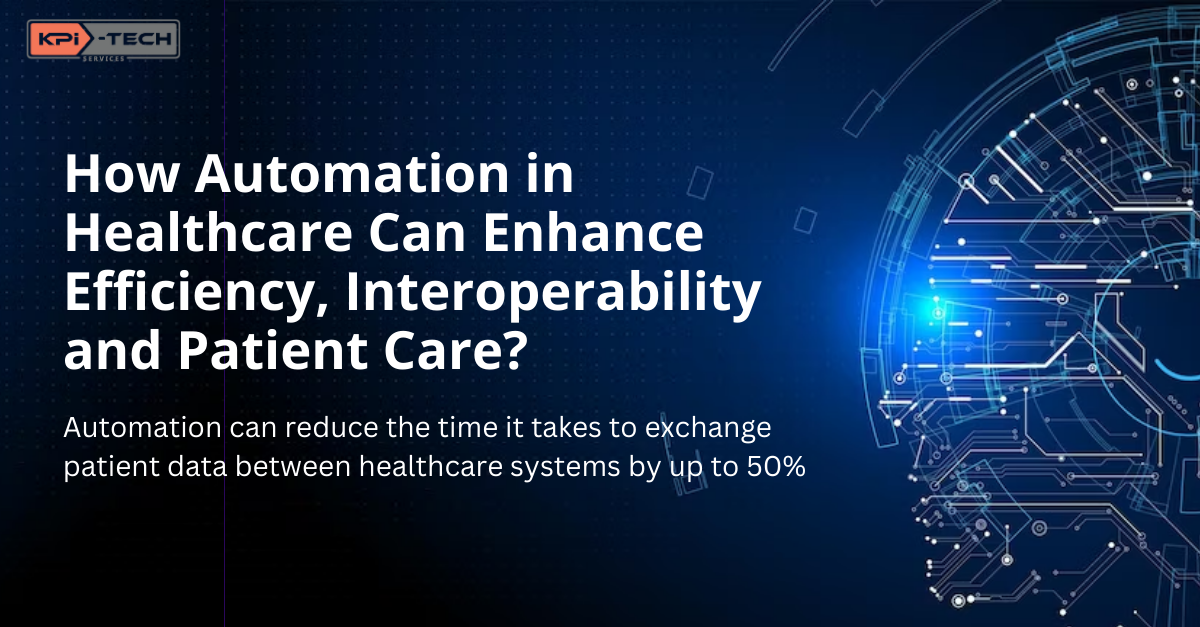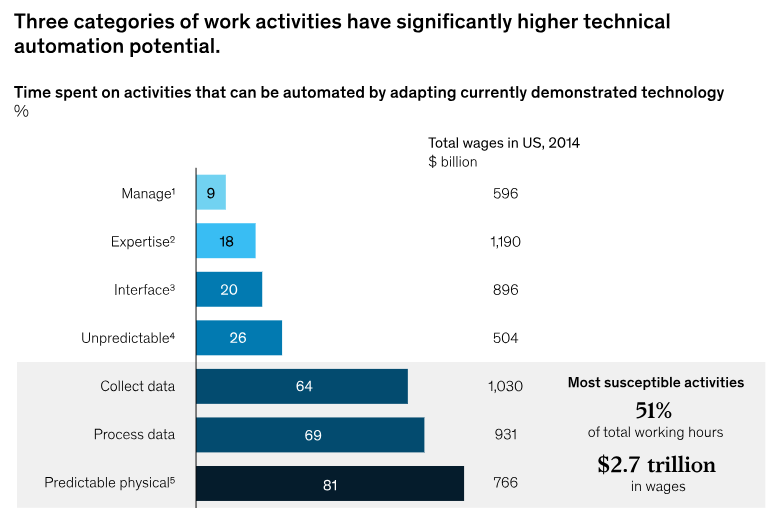
How Healthcare Automation Can Enhance Efficiency, Interoperability, and Patient Care?
Introduction
Meeting the ever-growing needs for better healthcare while grappling with rising operational costs and intricate supply chains has compelled healthcare systems to seek fresh approaches. The integration of artificial intelligence (AI) into healthcare has been ongoing, with a misconception that it's solely about robots.
A survey conducted in 2022 revealed that nearly 90% of healthcare organizations have embraced AI and automation strategies. In contrast, the figure was a mere 54% in 2019.
Leveraging cutting-edge digital technologies for automation has become imperative to cope with escalating demands for streamlined operations, heightened productivity, and the effective management of patient records. Healthcare automation encompasses the utilization of diverse software employing contemporary methods to enhance efficiency in healthcare services.
Automation in Healthcare: Key Areas of Significance
-
Healthcare Data Processing
Healthcare data is a valuable resource that can be harnessed to improve patient care, population health management, and clinical research. Data automation, achieved through software, makes data readily accessible for users and benefits healthcare organizations by cutting costs, boosting efficiency, improving quality, ensuring compliance, and automating tasks. Automation plays a crucial role in collecting, organizing, and analyzing vast amounts of healthcare data, enabling healthcare providers to make informed decisions that positively impact patient outcomes. Certain types of repetitive and routine activities, such as data collection and processing show a high automation potential.

Source: https://www.mckinsey.com/capabilities/operations/our-insights/making-healthcare-more-affordable-through-scalable-automation
Automation tools can efficiently extract data from various sources, including electronic health records (EHRs), medical devices, and insurance claims. This data can then be aggregated and analyzed using advanced analytics techniques, providing healthcare providers with insights into patient demographics, treatment patterns, and disease trends. These insights can be used to personalize care, identify potential risks, and develop effective interventions.
Steps to Implement Data Automation in Healthcare:- Identify data sources and formats for automation.
- Define business objectives and project requirements.
- Determine data access methods from various systems.
- Select suitable tools considering functionality, scalability, and cost.
- Specify rules and logic for data transformations.
- Develop and test the ETL (extract, transform, load) process.
- Schedule automated tasks for frequency and timing.
- Evaluate project outcomes, measure benefits, and impacts for the healthcare entity.
RELATED: KPi-Tech Reduced Hospital Report Generation Time by 95% with a Custom Web Application
-
Revenue Cycle Management (RCM)
Providers' Revenue Cycle Management (RCM) encounters significant hurdles due to outdated systems and intricate procedures, resulting in undesired claim denials.
A substantial 79% of RCM functions still rely on obsolete technologies housed in independent applications that don't integrate with various manual processes. Consequently, almost 20% of claims face denials, often stemming from authorization issues or charge capture problems.
Automation presents an opportunity to simplify convoluted workflows across critical RCM aspects, including pre-claim processes, seamless claim status reporting, patient encounters, transaction handling, and accounts receivable follow-ups. Healthcare institutions are increasingly integrating robotic process automation (RPA) and AI to replicate human actions in rule-based, repetitive tasks. This initiative aims to expedite task completion, streamline operations, enhance patient experiences, and reduce overall expenses.
RELATED: Empowering Women's Healthcare: Revolutionizing Payer Risk Contract Management
-
Clinical Workflow Automation
Workflow automation enables the autonomous management of repetitive tasks. Presently, the scope of automated healthcare extends beyond basic functions to encompass intricate responsibilities like inventory management, client billing, and IT operations.
The integration of medical healthcare into workflows brings about transformative changes by:
- Mitigating staff burnout
- Enhancing interoperability
- Overhauling processes related to healthcare information management
- Amplifying revenue
- Elevating data security
-
Administrative Efficiency
Automation streamlines administrative tasks, such as scheduling appointments, processing insurance claims, and managing patient records. This frees up healthcare providers to focus on patient care, leading to improved patient satisfaction and reduced wait times. Automated appointment reminders and online patient portals also enhance patient engagement and convenience
RELATED: CRM Automation Testing: Driving Efficiency in Healthcare Data Analytics for Higher ROI
-
Regulatory Compliance and Security
Automation assists in maintaining compliance with healthcare regulations by ensuring accuracy, consistency, and adherence to standards. Furthermore, it bolsters data security measures, mitigating risks associated with unauthorized access or breaches, safeguarding patient information.
Automation in Healthcare: How Can It Help Patients
Automation stands poised to revolutionize payers within the healthcare sector. This transformation presents a substantial opportunity estimated at $150 billion for operational enhancements. This includes reducing administrative costs, enhancing quality control, and gaining strategic insights. Among healthcare entities, payers stand to benefit the most from automation programs due to their heavy reliance on data collection and processing.
Healthcare Automation Benefits for Patients:- Early Disease Detection: Automation aids in detecting health issues beforehand, enabling early intervention for disease prevention or management.
- Enhanced Patient Experience: Automation reshapes patient experiences, improving satisfaction, encouraging recommendations, and reducing frustrations, especially with billing issues.
- Quick and Accurate Diagnostics: Automation ensures swift and accurate diagnostics, crucial in time-sensitive situations, and supports patients in adhering to treatment plans.
- Improved Care Quality: Automation minimizes human errors, ensures accessibility to patient information for better care, and enhances efficiency and patient management.
- Monitoring and Support: Automation facilitates continuous patient monitoring, medication reminders, and the use of mobile apps for streamlined care management.
Healthcare Automation: Enabling Provider Advancements
Enhancing efficiency in healthcare systems through advanced methodologies is a collective aspiration. According to McKinsey, an estimated 33% of healthcare provider tasks can be automated as part of reforms to reduce administrative complexity that could save $265 billion annually in the U.S. healthcare system alone.
- Automated case creation and note addition across multiple systems
- Consolidation of patient records for comprehensive access by attending physicians
- Facilitation of data exchange between departments to reduce administrative errors
Improving Efficiency, Accuracy, and Productivity
Implementing automation within hospitals yields higher throughput, enhanced accuracy, and reduced critical errors and operational costs. This streamlining of healthcare workflows allows employees to navigate tasks more smoothly, enabling them to assist a greater number of patients. AI-based systems handle mundane tasks, allowing medical professionals to allocate more time to patient-centered care.
Reduced Potential for Medical Errors
Introducing Robotic Process Automation (RPA) in healthcare minimizes human involvement, subsequently lowering the probability of errors in the healthcare process. This reduction in errors leads to more effective patient treatment through:
Reducing Staff Burnout
Manual, repetitive workflows often expose staff to stress, contributing to burnout and impacting morale and patient satisfaction. Healthcare automation alleviates the burden of repetitive tasks, allowing staff to focus on more complex or patient-centric demands.
Effective Cost Containment
Leveraging automated workflow technology leads to cost reduction by eliminating human errors, mitigating operational inefficiencies, and increasing overall capacity within healthcare systems.
Achieving Interoperability
Automation fosters better interoperability, enhancing comprehension of patients' needs while reducing costs and improving outcomes. Benefits include enhanced data accessibility, analysis of data trends, and reduction of redundant administrative tasks, boosting employee and patient satisfaction.
Enhanced Employee Satisfaction and Retention
Apart from enhancing patient satisfaction, organizational success hinges on the motivation and contentment of staff. Automating electronic healthcare forms reduces staff burdens, allowing employees to focus on providing stress-free and personalized care, ultimately enhancing patient retention.
Ensuring Data Security
Data security remains paramount in healthcare automation implementation. Reduced human involvement lowers the likelihood of data manipulation, thereby ensuring the security of organizational data.
Impact of Automation on Interoperability
Automation plays a crucial role in enhancing interoperability within the healthcare ecosystem. By streamlining data exchange and communication between disparate systems and organizations. Despite the rapid advancements in healthcare technology, time-consuming administrative duties continue to hinder efficient patient care. Automating workflows and data integration enables healthcare providers to swiftly access necessary information, freeing up more time to concentrate on patients rather than administrative tasks. Automation facilitates seamless access to patient information, enabling healthcare providers to make informed decisions and deliver coordinated care.
A report by the Office of the National Coordinator for Health IT found that automation can reduce the time it takes to exchange patient data between healthcare systems by up to 50%. Another study by the Healthcare Information and Management Systems Society (HIMSS) found that 67% of healthcare organizations are using automation to improve interoperability with other healthcare providers.
CIOs and other leaders in healthcare are being tasked with automation mandates to turn automation into a core competency that can help with imperatives like interoperability of systems and data integration.
RELATED: Automating Multi-Client Integration Verification for Enhanced Efficiency
Conclusion
As we delve into this era of technological advancements, it's crucial to recognize the transformative role of automation in reshaping the healthcare landscape. By leveraging innovative technologies like AI and automation, healthcare entities can effectively navigate the complexities of modern healthcare while prioritizing patient care.
This technological revolution is driven by the expertise and dedication of Healthcare Technology companies. KPi-Tech leads with 25+ years of healthcare IT expertise, crafting tailored automation solutions for efficient, patient-centered care. Our tailored automation solutions address the dynamic challenges within the industry, empowering healthcare providers to optimize data processing, revamp revenue cycle management, and enhance clinical workflows.
Ready to automate EMR workflows, claims systems, document management, data transfer, process intelligence and insights, and desktop inefficiencies? Contact us to know how KPi-Tech empowers your organization to automate it all.




